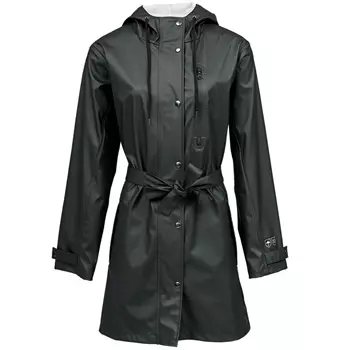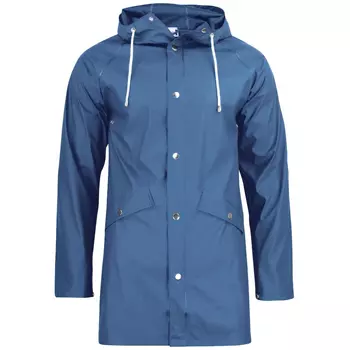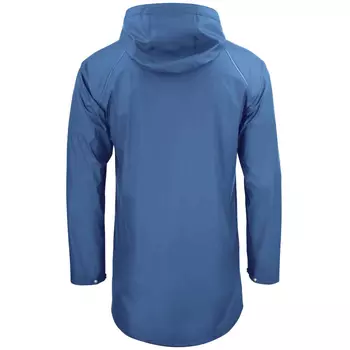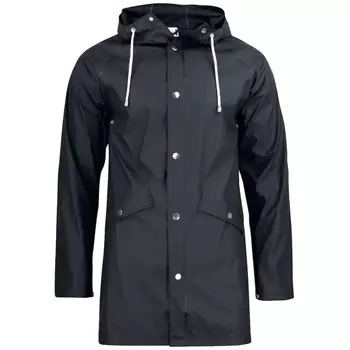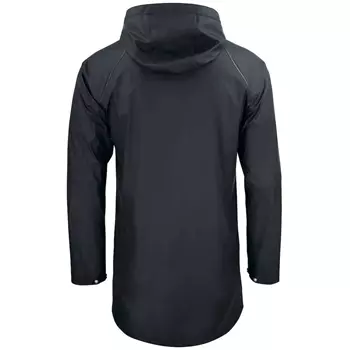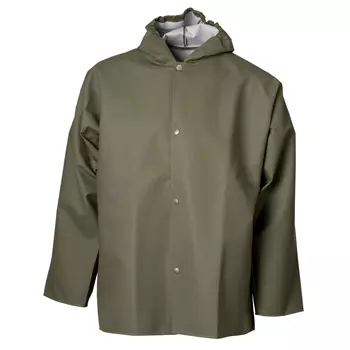Water column pressure and breathability in rainwear
Do you get confused when you see numbers for water column pressure and breathability, and is it important at all to know anything about it in order to buy rainwear? Basically, what you need to know is how waterproof and windproof your rainwear should be in relation to what you need it for.
Here in this rainwear guide, we describe water column pressure, breathability, and taped and welded seams, to help make choosing rainwear easier for you.
What does water column pressure mean for rainwear?
Water column pressure is measured in millimetres, and the higher the water column pressure, the more waterproof the item is. If your rainwear needs to be suitable for a full day’s work use, we advise you choose a water column pressure of at least 8,000 mm, and seams that are welded or taped. This way, your rainwear can withstand heavy rain, if you cycle or sit on a machine, for example. You can filter your search within our rainwear for a specific water column pressure on our page with rainwear. Select filters and then “Technical specification” and tick the water column pressure you want.
Below you can see our recommendations for water column pressure
| Water column pressure | Typically for use here |
|
Minimum 5,000 - 10,000 mm |
For daily use |
|
8.000 - 20.000 mm |
For work use |
Do you need breathable rainwear?
It depends on who is using the rainwear. Children do not sweat like adults, so they can do just fine with rainwear in PU, which is not breathable.
For active adults, breathable rainwear allows you to get rid of heat and moisture. If, on the other hand, the rainwear is not breathable, you will easily get cold and damp from sweat - and from this point, catching a cold might not be far off.
We get a little technical here (just call us rainwear nerds) but to understand breathability, we need to go into a little more detail. Breathability is known as MVP and is an abbreviation of the term Moisture Vapour Permeability in English. Don’t worry if you struggle to pronounce it, it simply refers to the amount of moisture that is wicked out through the rainwear membrane. MVP is stated in g / m2 x 24 h. I.e., the amount of moisture that can be wicked away per. square meters in 24 hours.
One rule of thumb, is that you should go for rainwear with a high MVP if you move around a lot.
You can filter our rainwear by breathability on our page. Select filter and then “Technical specification” and tick the water column pressure you want. But what is a high MVP then, and what is right for you? The numbers in the chart are our guideline and you should consider them advisory. Remember that how much you sweat differs from person to person. You must therefore also assess for yourself what level of breathability you need.
See our recommendations for breathability in rainwear here
| Breathability MVP | Typically for use here |
|
3,000-5,000 MVP |
Walking with a little effort |
|
5,000 - 8,000 MVP |
For work use |
|
8,000 - 10,000 MVP |
Moderate work and longer bike rides |
|
10,000 MVP and above |
Hard work and high activity for a long period |
Remember the welded or taped seams in rainwear too
Welded and taped seams are two different methods of making rainwear impermeable at the stitching. The welded or taped seams are just as important for making the rainwear impermeable as the material the rainwear is made from.
Taped seams mean that the seams are sealed with a special tape, making them waterproof.
Welded seams are seams that are welded together instead of being sewn together.
One method is no better than the other, and the difference in terms of when it is used depends only on the thickness of the material.
You can filter your rainwear search to include welded seams or taped seams on our page. Select filter and then “Technical specification” and tick the selection you want.
Rainwear with a membrane - what is this?
A membrane is an intermediate layer, i.e. a layer between the outer and the inner layer of rainwear. The function of the membrane is to keep the rainwear waterproof, windproof and breathable. The membrane keeps wind and water out whilst allowing excess heat and moisture to be released, so you do not get cold. You might have heard of shoes with a Gore-Tex membrane, which means that the shoes are waterproof? Similarly, there can be different types of membrane used in rainwear.
With a rain jacket, for example, a membrane helps to keep the air warmed up and kept inside, at the same time as the membrane allows excess heat to escape. That way, the body remains temperate and you can concentrate on working without sweating or getting too cold.
To maintain the function of the membrane, the rainwear must not be too dirty, as it can then start to absorb water and destroy the breathability. Do not use a fabric softener when washing clothes with a membrane as it destroys breathability just the same as dirt does. You can buy a detergent here called Nikwax Tech Wash. Its purpose is to maintain the function of the membrane during machine washing.
Can rainwear handle anything other than water?
Yes, you can choose rainwear that can withstand the grease, oil and blood that you are exposed to if you work as a fisherman, in a slaughterhouse, or in the cleaning industry.
Some rainwear brands also have work rainwear that is highly resistant to flames. In fact, you can get rainwear with flame retardant properties that you can use at sea, for example, to increase your safety.
In order for you to move around safely in connection with road work or work on a construction site, reflective rainwear is also available, which comes with high water column pressure and breathability. It's called Hi-Vis rainwear. If you want to find out what Hi-Vis means and whether you should choose Hi-Vis rainwear in class 1, 2 or 3, read more on this topic here.
We hope feel yourself to be better informed (and more of a rainwear nerd) by reading this guide, and that choosing your rainwear will be made easier.
Do you have other questions regarding rainwear?
If you are in doubt about what best suits your needs, you are always welcome to contact our
customer service at info@cheap-workwear.com or on tel. +45 9674 2030.
We are ready to help in finding the right rainwear for you.

